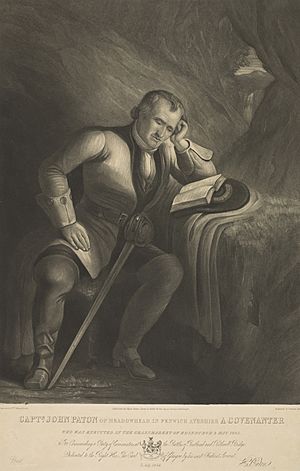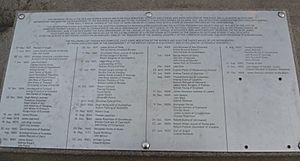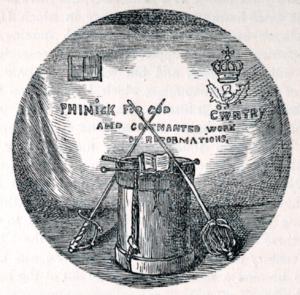John Paton (Covenanter) facts for kids
Quick facts for kids
John Paton
|
|
|---|---|

John Paton with two swords
|
|
| Born | Meadowhead, Fenwick |
| Died | 9 May 1684 (executed) Grassmarket, Edinburgh |
| Buried | |
| Allegiance | |
| Rank | Captain |
| Battles/wars | Battle of Lützen (1632), Battle of Marston Moor, Battle of Kilsyth, Battle of Philiphaugh, Battle of Worcester, Battle of Rullion Green, Battle of Bothwell Bridge |
John Paton was a brave Scottish soldier and a Covenanter. The Covenanters were a group of Scottish Presbyterians who wanted to protect their religion and way of life. John Paton was executed in Edinburgh on May 9, 1684. This happened mostly because of his actions at the Battle of Bothwell Bridge.
Contents
The Life of John Paton
John Paton was born in a place called Meadowhead, in Fenwick, Ayrshire. His family had a farm there. When he was young, he worked on the farm.
Early Military Adventures
Some stories say that John Paton went to Germany as a volunteer. He fought in wars with a famous leader named Gustavus Adolphus. He was so good at fighting that he became a captain. Other stories say he was with the Scottish army at the Battle of Marston Moor.
Fighting for Scotland
As a captain, John Paton fought bravely against Montrose at the Battle of Kilsyth on August 15, 1645. He managed to escape safely even when his side was losing. After Montrose was defeated at Battle of Philiphaugh on September 13, John Paton went back home to Fenwick.
He also joined the people of Fenwick to stand against General Middleton in 1648. Later, in 1650, he supported the king against Oliver Cromwell. He even went with the king to England in 1651 and fought for him at the Battle of Worcester on September 3.
The Covenanter Wars
After the king was restored to power in Scotland, John Paton continued to fight for the Covenanters. He led a group of Covenanter horsemen at the Battle of Rullion Green on September 28, 1666. During this battle, he even had a personal fight with a general named Thomas Dalyell. He was also at the Battle of Bothwell Bridge on June 22, 1679.
After these battles, the government wanted to arrest him. But John Paton was very good at hiding. He managed to stay safe in different places for a long time.
Capture and Trial
In 1684, John Paton was finally captured at the house of another Covenanter, Robert Howie. When General Dalyell met him, he said he was both happy and sad to see him. Dalyell respected Paton because Paton had fought for the king at Worcester. Dalyell even tried to help Paton get a pardon. Records show that Paton acted very respectfully during his trial.
John Paton's Death
John Paton was sentenced to be hanged at the Grassmarket in Edinburgh. His execution was first set for April 23, but it was delayed until May 9. He was willing to agree to certain conditions to save his life, but the government officials needed to be all together to make the decision, and they couldn't gather enough people in time.
John Paton was buried in Greyfriars Kirkyard in Edinburgh. There is a large monument dedicated to him in Fenwick Churchyard, remembering his life.
John Paton's Family Life
John Paton was married twice. His first wife was Janet Lindsay, whom he married around 1652. His second wife was Janet Millar, whom he married around November 1666. She passed away in or after 1684. John and Janet Millar had six children together.
John Paton in Poetry
A minister named James Dodds wrote a poem about John Paton. It's called "Meeting Of General Dalziel And Captain John Paton Of Meadowhead, When the Latter was brought Prisoner to Edinburgh, August, 1684." Here are the first two verses:
Hath his good sword her temper lost,
Or her master now forsaken?
Or why, such wars and dangers passed,
Is he a captive taken?
Nay, nay! his arm is powerful yet,
His sword as keen as ever;
But he is life-worn, and would fain
That God should him deliver.
The same that won his maiden scars
At Lutzen, famed in story;
And since, in every hard campaign,
Hath shared the toil and glory.
But chiefly to his native land
His heart and sword were given;
That she might keep her ancient rights
And her covenant with heaven.



